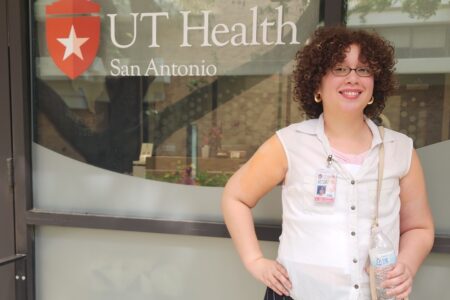Share On Social!
In the 22% Latino Fairfax County Public School District in Fairfax, Va., a parent group called Real Food for Kids had rid school cafeterias of highly processed junk foods and improved the nutrition of school snacks and menus. But the change was not very visible to students. So the group, led by parent JoAnne Hammermaster, helped bring a fresh food stations showcase the healthier selections—and add new ones—for students at district schools.
EMERGENCE
Awareness: Childhood obesity is a priority for the parent group Real Food for Kids (RFFK), which pushes for healthy changes in the Fairfax County Public School District (FCPSD), a 22% Latino district in Fairfax, Va.
In 2012, for example, RFFK drove FCPSD leaders to remove foods with artificial dyes, additives, and other highly processed ingredients from cafeterias, and replace these foods with fresh foods.
However, this change didn’t cause a visually healthy cafeteria, even the foods were healthier.
Learn/Frame Issue: Students weren’t getting interested in healthier foods because of the subtlety of the changes, said JoAnne Hammermaster, a parent and a founding member of RFFK.
“When you take the additives out of the food, there’s not much you can see and kids don’t know that,” Hammermaster said. “We wanted to start moving toward where the kids can see the change.”
Hammermaster and other parents brainstormed ways to showcase the healthier food.
They soon came up with an idea: Start a fresh foods station.
Fresh food stations, which differ from a traditional salad bar by offering more fresh fruits and raw veggies alongside customizable salads and sandwiches, would help make the healthy choice the easy choice for students and breakfast and lunch.
RFFK reviewed the district’s current lunch offerings and studied what foods might populate fresh food stations and meet USDA’s Healthy Hunger Free Kids requirements for school lunch.
DEVELOPMENT
Education: RFFK officials believed that fresh food stations would give students healthy, filling options for lunch and keep them away from high-calorie, high-fat snacks.
The group presented the idea to the FCPSD school board.
The school board loved the idea and wanted to offer support. However, they were hesitant to install new food stations in all the schools in the district because of their lack of testing and funding. They continued to discuss what options were available to make these goals happen.
Mobilization: The school board decided that they best way to move forward was to create a pilot food station, which would serve as the test fresh food station to determine the success of the new idea.
George C. Marshall High School was chosen to be the pilot school because they were undergoing renovations, including remodeling its cafeteria with enough space for a stand-alone food station.
Hammermaster began to set up a support team at Marshall, including Principal Jay Pearson and District Director of Food and Nutrition Services Penny McConnell.
Pearson was excited to make healthy eating a top priority for students, Hammermaster said.
“Without his support, help, and vision of what he wanted to create in his school cafeteria for the kids, it would not have come together,” Hammermaster said. “Kids are under a lot stress, they have a lot going on, and he believes lunch should be a time where they can unwind a little bit, get re-energized and refreshed with healthy food.”
Debate: RFFK and McConnell began to plan how to best fit the test fresh food station into Marshall’s cafeteria. They also needed a wide-variety menu for the station with healthy entrees, sides, and snacks.
ENACTMENT
Activation: RFFK got students involved to ensure the station would be popular.
They held a competition at Marshall High to create a brand for the fresh food station and help design the station’s locale. Students voted to name the station “Statesman Station” after the school’s namesake, Marshall Statesman.
Students were also involved in taste testing soups and other foods that RFFK hoped to include in the fresh food station. They wanted to bring much more than salad to the students, hoping to offer a variety of freshly prepared soups and sandwiches to serve as entrée meals with the other fruits and vegetables.
Frame Policy: The team started finalizing a station menu full of healthy options that met student input and UDSA nutrition guidelines.
The team also finalized the design and incorporated it into the ongoing renovations.
This standalone station would have a Statesman Station sign, its own line in the cafeteria, separate from the traditional cafeteria serving section.
Change: RFFK presented the new menu and plan for the next school year to the principal, Pearson, who immediately approved. Having been on board with this project from the beginning, Pearson was very excited to be able to provide delicious, healthy options to students as soon as possible.
“It’s not just a salad bar. It’s more of an expanded salad bar that has other options,” Hammermaster said. Everything has to be fresh; freshly made sandwiches and simple entrée items that can be made at school.”
IMPLEMENTATION
Implementation: Statesman Station opened at Marshall for the fall semester in 2013.
Students were able to get fresh fruits and vegetables, make their own salads, and get freshly prepared soups and sandwiches from the new food station.
The school hosted a ribbon cutting to celebrate the opening of Statesman Station at Marshall, honoring those who worked to get the food station implemented into the school.
A group of students wrote and prepared a rap song to perform at the ribbon cutting, to thank the food services and RFFK for bringing them more healthy food. Lyrics included: “School nutrition needs some switchin, introducing Marshall’s pilot kitchen. We love the cookies, but they’re not sufficient. We need veggies to make our bodies efficient.”
Students have since created two recording of the song; one specific to Statesman Station and one that applies to healthy eating nationwide.
Equity: Statesman Station has become very popular with students and is continuing to provide them with fresh, healthy options.
The Nutrition club at Marshall conducted a student survey to find out what students liked about Statesman Station, and where the school could improve. Students love the variety of options, the availability of produce, and the healthy options they can get every day.
However, many students also find that the lines are far too long, and they often go through the regular lunch line to save time. RFFK and Marshall are trying to amend this issue by finding a way to open up both sides of the station, as opposed to only having access to the one side that is open now.
Sustainability: As the pilot kitchen, Statesman Station has been very successful.
The FCPS School Board is so impressed with the station at Marshall that it plans to add similar Statesman Stations in high schools and middle schools throughout the district, Hammermaster said.
The district will start by implementing 10 stations in the 2014-15 school year, and the rest of the 25 total high schools over the following two years. After all high school stations have been implemented, stations will be added to middle schools, too.
RFFK and district officials continue to fast-track healthy changes like these.
“When this was unveiled at a work session, several school board members said this isn’t fast enough and that everyone has been waiting years, but now they have to wait three more years to get fresh food,” said Hammermaster, noting that the demand for healthier change is always a positive.
This success story was produced by Salud America! with support from the Robert Wood Johnson Foundation.
The stories are intended for educational and informative purposes. References to specific policymakers, individuals, schools, policies, or companies have been included solely to advance these purposes and do not constitute an endorsement, sponsorship, or recommendation. Stories are based on and told by real community members and are the opinions and views of the individuals whose stories are told. Organization and activities described were not supported by Salud America! or the Robert Wood Johnson Foundation and do not necessarily represent the views of Salud America! or the Robert Wood Johnson Foundation.
ABOUT THE PROGRAM
Salud America! The RWJF Research Network to Prevent Obesity Among Latino Children is a national program of the Robert Wood Johnson Foundation. The program aims to educate researchers, decision-makers, community leaders, and the public in contributing toward healthier Latino communities and seeking environmental and policy solutions to the epidemic of Latino childhood obesity. The network is directed by the Institute for Health Promotion Research at the University of Texas Health Science Center at San Antonio.
For more information, visit http://www.salud-america.org.
By The Numbers
142
Percent
Expected rise in Latino cancer cases in coming years
This success story was produced by Salud America! with support from the Robert Wood Johnson Foundation.
The stories are intended for educational and informative purposes. References to specific policymakers, individuals, schools, policies, or companies have been included solely to advance these purposes and do not constitute an endorsement, sponsorship, or recommendation. Stories are based on and told by real community members and are the opinions and views of the individuals whose stories are told. Organization and activities described were not supported by Salud America! or the Robert Wood Johnson Foundation and do not necessarily represent the views of Salud America! or the Robert Wood Johnson Foundation.



